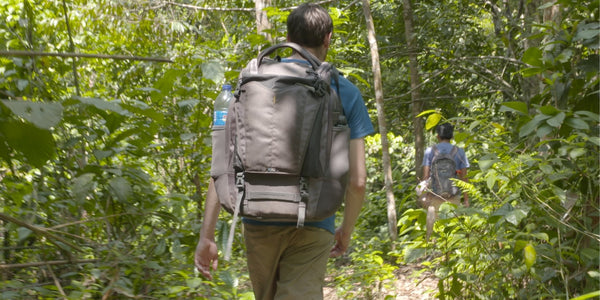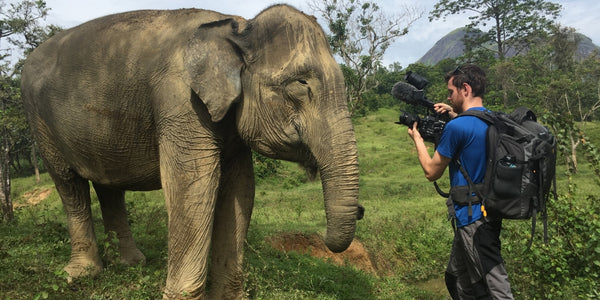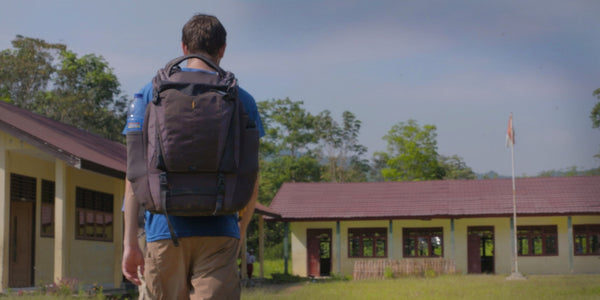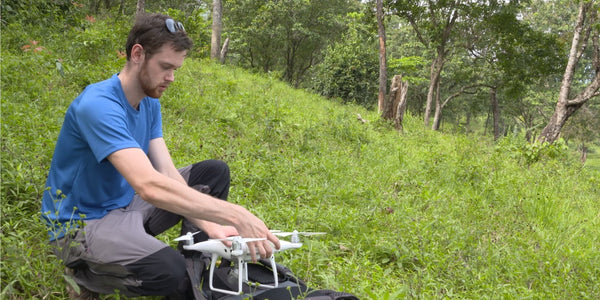It’s hard to escape the news from Indonesia of deforestation, poaching, palm oil and pet trades. I must admit, I thought this could be a place of lost hope. However, a message from Pungky Nanda Pratama, a conservationist working in the island of Sumatra, made me rethink. He told me of conservation actions that I had no idea about. It wasn’t long before I decided that this story needs to be told as a documentary. A few months later, I was on a plane.
Day one, I paused for thought deep in the Sumatran Rainforest. Steeped in the sound of buzzing insects, whistling birds and howling gibbons. I was in the thick of it. Looking around I see nothing but ancient forest; trees covered in vines, the age-old struggle for light in this dense ecosystem. I find myself in a place of unfathomable beauty, abundant wildlife, and yet I struggle to be happy, knowing that the future of these individuals, species, ecosystem, will be cut short is a heartbreaking reality. This orchestral symphony will soon fall silent.

An image of unspoilt Sumatran Rainforest
I was there with Pungky and our task for the day was to find as many orchids as possible to take back to his nursery where he can propagate them. Relatively understudied, orchids are a huge part of the ecosystem. Certain species rely solely on a certain species of orchid. Therefore, by saving this one species of orchid, subsequent species are saved. Returning from the rainforest with hands, pockets, bags, filled with orchids, we felt we did the best we could. With my camera out filming this process, Pungky seized the opportunity to fill my Alta Sky 53, turning it into a multi-purpose bag.

My Alta Sky 53 backpack that quickly became a multi-purpose bag as I collected orchid samples with Pungky
My time in Sumatra was dedicated to capturing these incredible stories of individuals and groups working together to protect the land that they love. I interviewed ex-illegal loggers who have now been given the opportunity to earn their money as beekeepers. I visited elephant sanctuaries. The elephants here were causing damage to palm oil crops and the owners were angry, so the Conservation Agency of South Sumatra stepped in and provided sanctuary for the elephants. An unfortunate consequence of their safety meant they had to be kept on a long chain, which they would be let off in intervals. However, the repercussions of releasing them fully, would ultimately be death if they were to return to the palm oil crop. This is only a temporary holding, for the agency is developing a release site where they can be free from humans.

Meeting giants at Lahat Elephant Sanctuary
As part of my journey, I wanted to capture hope for the future. To provide this, I needed to show and educate the audience on why it may be deemed hope-less. One elephant sanctuary we visited required a six hour drive. Over half of that journey was spent driving through a massive palm oil plantation. I couldn’t fathom the size of the plantation. Over three hours and all I could see was row after row of palm oil. The visuals alone were shocking, but the seemingly silent soundscape was a haunting reality check. All of this used to be rainforest. A place where tigers roamed and elephants paraded.
I visited the head of the South Sumatra Conservation Agency in Palembang city. There I learned more about the issues they were facing. Illegal logging and poaching were top of the list. I was given behind the scenes access and shown the devastation of poaching. In this dark, scorching room, sat two stuffed Sumatran Tigers, and a stuffed Sun Bear. Two apex predators reduced to a mere ornament. A harrowing site, one which upset Pungky and myself. I could not comprehend why someone could do this. I wanted answers and so we set out trying to interview ex-poachers to gather some understanding.

Heading to rural schools, laptop in the Alta Sky 53 ready to teach the kids about plastic pollution
Sure enough, nobody wanted to speak to use. They feared that I was there to arrest them and we could not reassure them. Eventually we found someone who said ok. Now working at the plant nursery, he told us stories of when he used to poach. “Why did you do this?” I asked. “I had no job, no money, and there were no opportunities for me. I had to do it to get money to feed my family.” he replied. He was not this malicious man I had conjured in my mind. He was a calm and gentle soul, one you’d expect ‘wouldn’t hurt a fly’, and yet faced with adversity, he did what he could to protect his family, despite the costs to the environment.
Perhaps to protect the environment we must look no further than ourselves - humans. For how can we protect the rainforest, when the need to live, eat, earn money is a basic human right. I believe the ‘miracle cure’ for nature is already happening. Giving people sustainable jobs which benefit them and nature is a no-brainer. The agency doesn’t punish illegal-loggers (on the first instance anyway), instead they give them a job, a means of earning money and feeding their family. After-all, this is all they ever wanted, to support their families. There will still be poachers who do it as a ‘hobby’, but speaking with people in Sumatra, it seems that the majority only do what they do for money, for food, for a life. Those illegal-loggers now working as beekeepers said they have never been happier. No longer under the stress of providing for the family whilst dodging the law.
The whole experience was eye-opening. Prior to this, I had only ever seen the negative news stories about Sumatra. Forest destroyed, Orangutan without a home, Tigers into taxidermy. It is devastating that this exists, however, I am filled with hope having seen the relentless actions of conservationist working in Sumatra. Nevertheless, they still need all the help and support we can give. But their determination alone eases my worry for the future, and seeing the incredible work they are doing, I now envision a recovering Sumatra where tigers can roam and elephants can parade.
You can support the amazing work that is being carried out there by following the ‘Sumatra Camera Trap Project’ and the ‘Jungle Library Project’ in Sumatra. To find out more about the documentary ‘Conserving Sumatra’, follow JEGS Media on social media where updates will be posted. All information can also be found at www.jegsmedia.co.uk.
Facebook - Twitter - Instagram
Review of Vanguard Alta Sky 53
Filming in one of the harshest environments in the world requires equipment that can handle these conditions. One of the most important of which is the camera bag. After all, this is used to transport my kit and keep it protected. Carrying it on a daily basis, I require it to be tough. Having spent a month in Sumatra, the Vanguard Alta Sky 53 has been incredible. It has been everywhere, from the deepest lowland rainforest, to the top of a volcano. Throughout it has kept my equipment safe, secure and dry. It is surprisingly comfortable considering its size and weight of my equipment. The ergonomic Air System is a fantastic feature.
Inside there is plenty of room to fit my large Sony FS7, Nikon D810 and variety of lenses including large telephoto, macro, wide and primes. The plethora of pockets, compartments and fasteners meant I could fit and attach almost anything including food, water and my drone. Being the dry season, it didn’t rain much, but when it did, the outer rain cover worked great, properly repelling the water.
The material is very strong. The bag has been through thick vegetation, so it has been scratched, scraped, bashed and yet the material is intact and still looks relatively new. The thick material on the bottom is great as I was always putting it onto rough ground. The fasteners on the outside stay tight and the zips stay closed.
All of its amazing features gave me the confidence to carry my equipment securely throughout the trip. For anyone doing similar trips, or leisurely trips with your camera, I highly recommend the Vanguard Alta Sky 53
James Stevens
Born and bred in the Cotswolds, UK, I have always been fascinated by nature. From a young age I knew that I wanted a career in wildlife, and after buying my first camera at the age of 11, I decided wildlife filmmaking was for me. Tailoring my whole education to this career, I finally graduated in 2016 with Wildlife Media (BA Hons). Leaving university I headed straight to the Cairngorms National Park where I would spend the next two years living and filming wildlife. Dubbed as being the wildest place in the UK, I felt at home there. Before long I was also a wildlife guide and this allowed me to extend my knowledge in the natural world.
With my sights set on bigger projects, I started planning my own documentaries. One looking at how a sleddog centre is being affected by climate change, another set in Papua New Guinea looking for new species and the other focusing on conservation in Sumatra. Sleddogs and Sumatra are still in work whilst Papua New Guinea is looking to being in 2019. I am at the start of my journey and I hope that through my work, I can promote and encourage positive change for the natural world.

James Stevens with his Vanguard Alta Sky 53
The post In The Thick Of It - A Journey Through Sumatra - by James Stevens appeared first on Blog.


